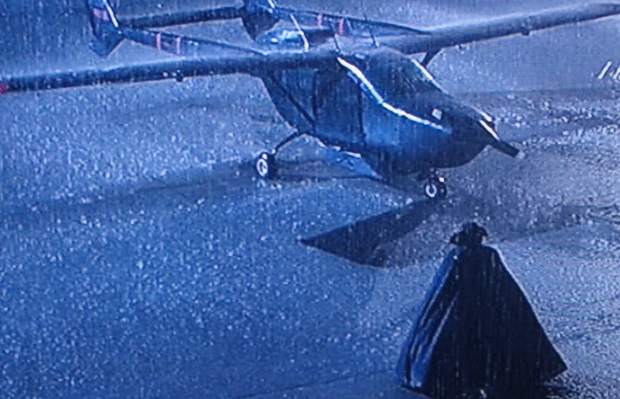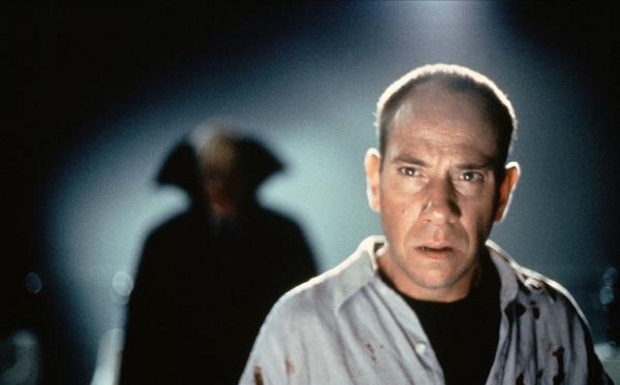Revisiting the film of Stephen King’s The Night Flier
Our Stephen King lookback series returns with this 1997 tale of an airborne serial killer...
This article comes from Den of Geek UK.
The film: A serial killer going by the name of Dwight Renfield (after Dwight Frye and his character in Tod Browning’s Dracula) has been flying across America, attacking people at small, local airports before flying off to his next victim. His MO? Draining his victims of blood. Richard Dees (Miguel Ferrer) is a tabloid reporter for Inside View with some serious anger management issues and that good ole healthy disrespect for authority figures required of such a main character. He reluctantly decides to follow the story when a rival reporter, Katherine Blair (Julie Entwisle), is assigned instead.
Vampires aren’t the most common monsters in Stephen King’s oeuvre. His most well-known and solely vampire-devoted Salem’s Lot also happens to be a really great one with other vampires cropping up in short stories and The Dark Tower series. The Night Flier appeared in King’s Nightmares & Dreamscapes short story collection and is adapted and directed here by Mark Pavia, who was given only thirty days to film.
For the most part, the tight filming schedule doesn’t show on screen, but occasionally it feels a little rough around the edges. For example, Dees’ first encounter with his editor features a hovering boom mic and a couple of the sets seem to have come from the same workshop that built Acorn Antiques. The dialogue can be a bit ropey in places and characters are slotted firmly into archetypes (Angry Reporter, Naive Junior Reporter, Smarmy Editor, Hick) so the story can feel a little thin. It doesn’t help that Dees isn’t all that likeable and you sort of end up wishing Renfield would rip his throat out, just to stop him yelling.
Where the film makes up for it is in the atmosphere it creates as Dees pursues the story through the backwaters of America, photographing and piecing together the story as he goes. Misty, moonlit airfields are a big factor in the majority of these creepy scenes and there’s a cameo by a vicious dog that brings back unnerving memories of a pooch named Cujo. The tension builds effectively enough that even the sight of a vampire in a full Lugosi-esque high collar cape looming out of the fog seems par for the course rather than a bad idea at a Halloween party. Sadly, the film is tempted into showing off Renfield in all his prosthetic glory, which is a mistake. He’s much better as a shadowy figure at the edge of the proceedings. Plus, he sort of looks like the cat people from Sleepwalkers…

There’s a fun parallel to be had here between the metaphorically bloodthirsty journalists and the literally bloodthirsty vampire. Dees’ editor even declares “God, I hope he kills more people!” at one point, just in case the connection hasn’t been made entirely clear. It’s one element of a low-key black humour that runs through the film, but it’s one that isn’t mined enough to balance out the more gruesome aspects in the way it seems to have been intended. That being said, the ending might be the biggest kicker of all. I’m also about to spoil it royally in the next paragraph, so if you want to avoid it, skip it!
During the big climactic hallucination in which Dees sees various dead bodies come back to life to attack him, he grabs a fire axe and starts swinging blindly, before a pair of cops command him to stop. The hallucination breaks for the audience and there he is, covered in blood and looking like he’s slaughtered a bunch of people, but Dees is in a frenzy. He runs at the cops, who shoot him dead. All witnessed by rival reporter Katherine, who Dees had locked in a cupboard to ensure he gets the story, only for her to pin all the killings on him and get that career break she’s been craving. Bloodthirsty journalists beget bloodthirsty journalists in much the same way that vampires are created. Katherine consumes Dees’ story and tanks his reputation, all for that front page.
As with many of these Stephen King adaptations, The Night Flier isn’t outright awful, but nor is it particularly great. However, I get the impression that had Pavia had a little more time and a little more budget to play with, the film would be further up the quality scale. As it is, it’s a fun, gory thriller with something to say for itself, even if Miguel Ferrer only seems to have one volume setting with which to say it.

Scariest moment: In his final encounter with Renfield, Dees drinks some of his blood, which induces a truly horrible hallucination. The victims of the Wilmington massacre start emerging from a fog coating the floor (the smoke machine budget for this scene alone must’ve been insane) as well as spectres from Dees past. It’s all shot in black and white with the low score at its creepiest. Shiver-inducing.
Musicality: Brian Keane’s score is fairly horror-by-numbers for the most part, but he resists any stereotypical strings for the big moments, and instead opts to stay at the quieter end of the spectrum with a rolling piano theme that is about as lively as it gets.
A King thing: Another intertextual connection for this one. Richard Dees is the reporter who tries to get an interview with John Smith in King’s The Dead Zone. The various Dees bylines that Katherine reads are all references to other King tales and Derry is also mentioned at one point.